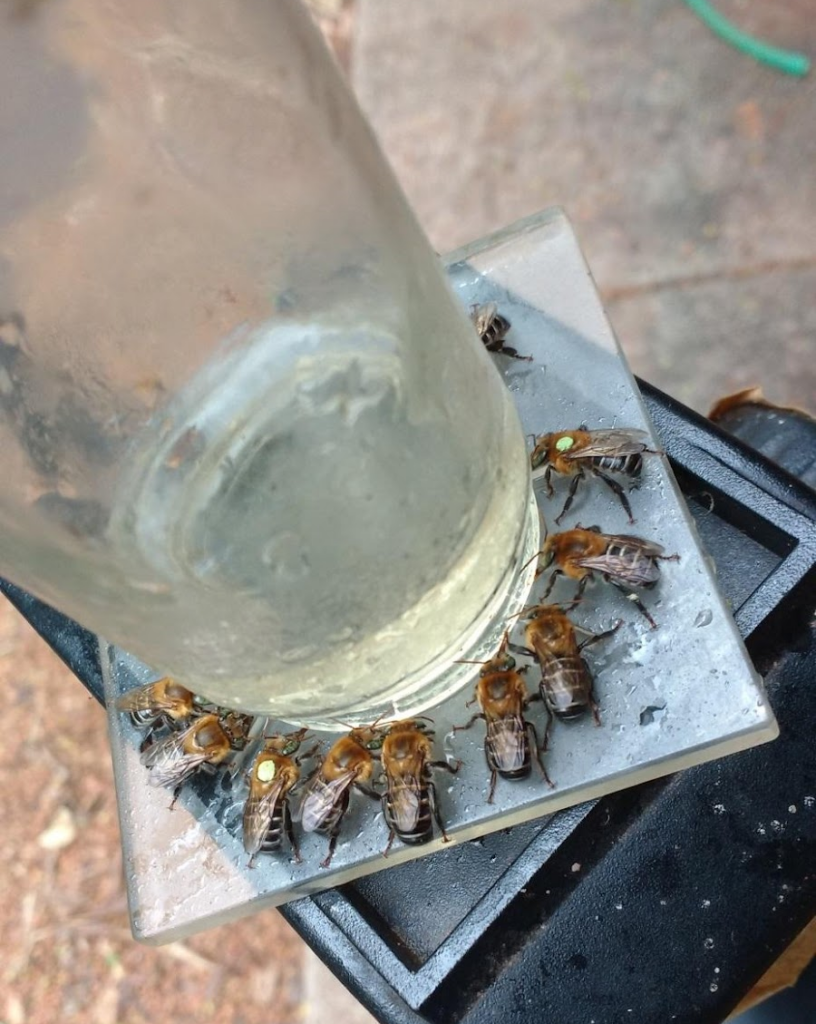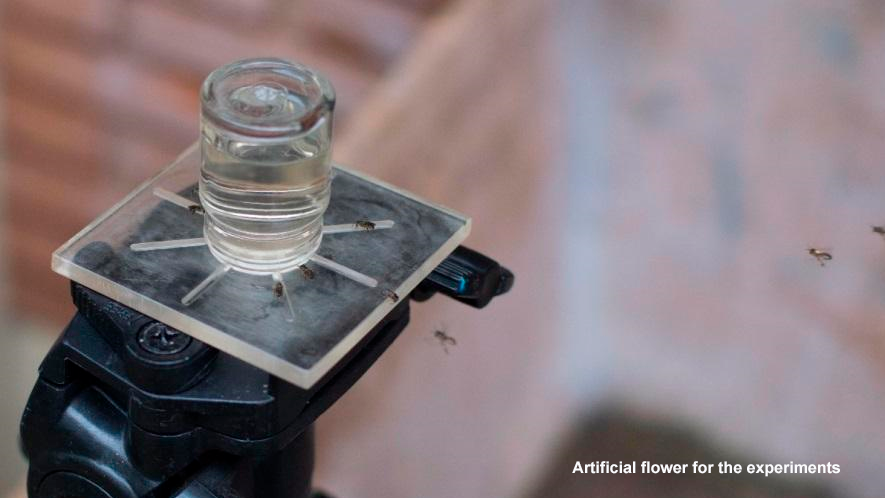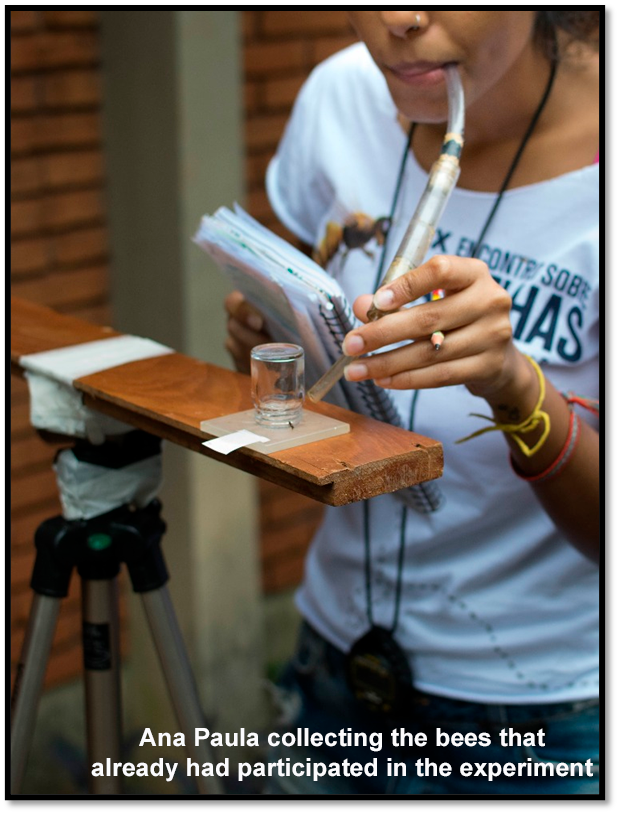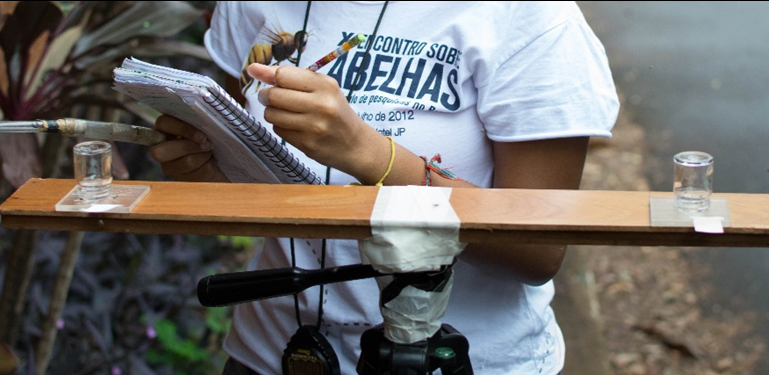In Brazil there are around 300 species of stingless bees and research with these pollinators is important so that we can understand our biodiversity and protect the nature around us! The researcher Ana Paula Cipriano explains to us a little about her work with bees.
Autora: Ana Paula Cipriano
Leia em português.
The stingless bees, also known as Meliponini, need great organization to achieve all the tasks necessary for their survival, like defending nests and obtaining food. And, when a bee is searching for flowers to collect pollen and nectar, do you know how it choses where to land?
First, it is important to understand how bees communicate with each other, since they have no spoken language, much less written language to transmit information. A very efficient signal that some bees’ species utilize to communicate is through chemistry, using little compounds which can be deposited on the leaves and flowers around the nest. A group of said compounds can be called pheromones and they are specific for each function. For example, when we catch a bee with our hands, or get close to a nest, they secrete a characteristic smell, and other bees start to get closer, we can call this compound alarm pheromone: it is the signal that these bees and their nest might be in danger!
In the search for food in the flowers, the bees also use pheromones, but in this situation, it is called trail pheromone. That is a smell they utilize to map the path to the flowers and guide other bees from their nest, showing in which direction the food is. In this case, we must remember that in Brazil there is a great diversity of stingless bees, and it is expected that they will meet each other in the flowers, often competing for food.

To better understand this situation, let’s imagine ourselves in a street fair, in which we are walking in search of food and, at the same time, smelling many different perfumes of the other people that are there. If a fair stall has many people, the smell of perfume will be much stronger in there and we will know that the place is full and we will have to compete for the best tomatoes, for example. Now, imagine that some people always compete for tomatoes, also they all use the same perfume and we can recognize that those people with that specific smell are very aggressive! If we are calmer people and don’t want to fight, we should avoid those people, correct? And it was exactly this idea that I wanted to study with the stingless bees during my research in my undergrad in Biological Sciences.
The main goal of my project was to understand if bees with different food search strategies were able to detect the smell of more aggressive bees and if they would avoid the flowers with this chemical compound, to avoid conflict and get food! For this, I studied two native bees’ species, Plebeia droryana, also known as mirim bees, and Melipona scutellaris, commonly called uruçu nordestina. These two species are known to not be aggressive, and they search for food in small groups, therefore, they don’t dominate the flowers.
To test if these two species can recognize and avoid the smell of other bees that visit the flowers in large groups, known to dominate the flowers, we utilised the smell of two species, Trigona spinipes – known as arapuá, one of those bees that stick in our hair, and Trigona recursa, known as feiticeira. The arapuá are considered aggressive, while the feiticeira are not aggressive, in spite of dominating the flowers with many bees. Studying these species, we were able to test if the stingless bees can detect which species is on the flower when choosing food, and if this choice may represent danger to them, like a conflict between worker bees, for example.

The trials were performed with the mirins bees and after it with the uruçus nordestinas. The workers were trained to visit artificial flowers with a mixture of water and sugar. Once these workers were already visiting the artificial flowers in a good number, the trail pheromone of one of the Trigonas species was added. We registered the behaviour of the bees and verified that both species prefer not to visit the flowers with the arapuá smell, when it was present in a higher amount. The smell representing the feiticeira did not cause any different reaction in these bees. Therefore, we verified that they could differentiate the smells and avoid the conflict of competing for a flower with several other workers from other species that are considered aggressive. The workers bees may increase their efficiency when searching for flowers that are free from other competitors.
We can consider the stingless bees’ workers that are searching for flowers as eavesdroppers. Since they investigate the environment around them, analyze the smell of others bee’s species that are visiting the flowers as well and then decide to look for other flowers that do not represent a competition.
The results of the research indicate that the factors that guide the different species of stingless bees to choose the flowers are diverse and the bees have a great ability to differentiate smells, even in an environment with lots of interactions. When visiting the flowers to obtain food to their nests, these indigenous bees are doing the important work of pollination, which is essential to the regeneration and conservation of our biodiversity. To learn more about this amazing world of stingless bees, the great inspiration for Meli, keep following our blog and social media.

The research was carried out at the University of São Paulo (USP) in Ribeirão Preto, at the Laboratory of Behavior and Ecology of Social Insects, coordinated by Professor Dr. Fabio Santos do Nascimento, with the collaboration of Dr. Lucas von Zuben and funding from FAPESP [process: 2014/24230-8].
Your donation can impact the world positively!
Subscribe to receive our Newsletter!
Find us also at Linkedin, Facebook, Twitter or Instagram
www.meli-bees.org
❤️


One Reply to “Pollination and eavesdropping: did you know that stingless bees can be great spies? ”